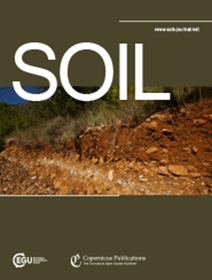评估复杂人工神经网络模拟小规模水土流失的潜力
IF 4.3
2区 农林科学
Q1 SOIL SCIENCE
引用次数: 0
摘要
摘要。水对土壤侵蚀的准确模拟对于制定有效的缓解战略和防止农业地区的现场和场外损害至关重要。到目前为止,复杂的人工神经网络在小尺度土壤侵蚀模型中的应用很少,其潜力仍不明朗。本研究比较了不同神经网络架构在农田小空间尺度上的水土流失模拟的性能。该分析基于5米× 5米分辨率的侵蚀率数据,来自一个20年的监测项目,覆盖了德国北部6个调查区域的458公顷农田。与地形、气候、管理和土壤性质相关的19个预测变量被选择作为输入,以评估它们与观测到的侵蚀模式的相互关系,并预测持续的土壤侵蚀率。应用单层神经网络(SNN)、深度神经网络(DNN)和卷积神经网络(CNN),并对随机森林(RF)模型作为基准进行评估。所有机器学习模型都成功捕获了土壤侵蚀的空间模式,CNN在所有评估指标上的表现都优于其他模型。CNN实现了最低的均方根误差(RMSE: 1.05)和平均绝对误差(MAE: 0.41),优于RF (RMSE: 1.31, MAE: 0.58)和SNN (RMSE: 1.48, MAE: 0.63),而DNN的表现与CNN相似,RMSE(1.1)和MAE(0.45)略高。CNN在评估其准确预测给定类别内土壤侵蚀的能力时,明显优于其他三种方法,其加权平均F1得分为0.7。排列重要性分析表明,数字高程模型是所有模型中最具影响力的预测变量,贡献率在15%至18.3%之间,而USLE C和R因素也具有显著的重要性。总的来说,这些发现突出了复杂神经网络在预测空间明确的水土流失速率方面的潜力。本文章由计算机程序翻译,如有差异,请以英文原文为准。
Assessing the potential of complex artificial neural networks for modelling small-scale soil erosion by water
Abstract. Accurately modelling soil erosion by water is essential for developing effective mitigation strategies and preventing on- and off-site damages in agricultural areas. So far, complex artificial neural networks have rarely been applied in small-scale soil erosion modelling, and their potential still remains unclear. This study compares the performance of different neural network architectures for modelling soil erosion by water at a small spatial scale in agricultural cropland. The analysis is based on erosion rate data at a 5 m × 5 m resolution, derived from a 20-year monitoring programme, and covers 458 hectares of cropland across six investigation areas in northern Germany. Nineteen predictor variables related to topography, climate, management and soil properties were selected as inputs to assess their interrelationships with observed erosion patterns and to predict continuous soil erosion rates. A single-layer neural network (SNN), a deep neural network (DNN), and a convolutional neural network (CNN) were applied and evaluated against a random forest (RF) model used as a benchmark. All machine learning models have successfully captured spatial patterns of soil erosion, with the CNN consistently outperforming the others across all evaluation metrics. The CNN achieves the lowest root mean squared error (RMSE: 1.05) and mean absolute error (MAE: 0.41), outperforming the RF (RMSE: 1.31, MAE: 0.58) and the SNN (RMSE: 1.48, MAE: 0.63), while the DNN performs similarly to the CNN with a slightly higher RMSE (1.1) and MAE (0.45). The CNN notably outperforms the other three approaches when evaluating their capability to accurately predict soil erosion within given classes, achieving a weighted mean F1 score of 0.7. A permutation importance analysis identified the digital elevation model as the most influential predictor variable across all models, contributing between 15 % and 18.3 %, while USLE C and R factors also had significant importance. Overall, these findings highlight the potential of complex neural networks for predicting spatially explicit rates of soil erosion by water.
求助全文
通过发布文献求助,成功后即可免费获取论文全文。
去求助
来源期刊

Soil
Agricultural and Biological Sciences-Soil Science
CiteScore
10.80
自引率
2.90%
发文量
44
审稿时长
30 weeks
期刊介绍:
SOIL is an international scientific journal dedicated to the publication and discussion of high-quality research in the field of soil system sciences.
SOIL is at the interface between the atmosphere, lithosphere, hydrosphere, and biosphere. SOIL publishes scientific research that contributes to understanding the soil system and its interaction with humans and the entire Earth system. The scope of the journal includes all topics that fall within the study of soil science as a discipline, with an emphasis on studies that integrate soil science with other sciences (hydrology, agronomy, socio-economics, health sciences, atmospheric sciences, etc.).
 求助内容:
求助内容: 应助结果提醒方式:
应助结果提醒方式:


